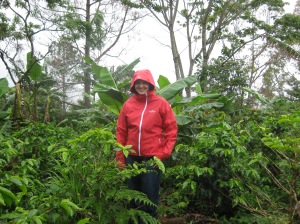“No one can understand the truth until he drinks of coffee’s frothy goodness.”
~ Sheik Abd-al-Kadir
Ah coffee. How I love thee so.
I firmly believe the second best way to be woken up in the morning is by the aroma of a freshly brewed cup of coffee. Even better if it’s the aroma of a coffee someone else has made for you.
I’m getting ridiculously spoilt here, as each morning our lovely housekeeper has my breakfast and accompanying coffee ready and waiting for me on the kitchen table.
My first coffee of the day is black, and then my second is normally a latte of dubious quality from the UN building’s Espresso Americano kiosk.
I’ve whinged about the poor quality of cappuccinos etc. here in Honduras before. Honduran coffee itself, on the whole, is excellent. If you drink your coffee black, you’ll be as happy as a pig in mud.
It’s the latte and flat white drinkers of the world who will struggle to find a good brew here. So I guess what I’m trying to say is: yuppies beware—your orange-mocha-frappuccino may not be up to your usual standard.
I have to admit that despite all the publicity about fair trade and rainforest alliance coffee these days, I don’t often pause to think about where my coffee has come from.
The other weekend I got the chance to get up close and personal to a cup of coffee’s origins. We travelled to Güinope—pronounced win-nop-eh—the original home town of my host family.
My host-uncle has a coffee plantation up in the hills behind the town. It was an overcast and drizzly day, but at least that meant it was nice and cool as we wandered around the farm.
 I was surprised to learn coffee plants need shade, so are always planted with another crop, such as banana trees to give them cover from the sun. I had imagined the hills would be rather bare with only low rows coffee plants, but the shade crop made it look more like a neat jungle, planted by an OCD Tarzan.
I was surprised to learn coffee plants need shade, so are always planted with another crop, such as banana trees to give them cover from the sun. I had imagined the hills would be rather bare with only low rows coffee plants, but the shade crop made it look more like a neat jungle, planted by an OCD Tarzan.
 The harvesting season is well and truly over but we were able to see the different stages of growth, from white flower buds, to unripe green berries, and we also found a few red ripe berries that had been missed in the harvest.
The harvesting season is well and truly over but we were able to see the different stages of growth, from white flower buds, to unripe green berries, and we also found a few red ripe berries that had been missed in the harvest.
The entire harvest is done manually, which is a labour and time-intensive process. My uncle’s plantation measures about 25 manzanas. The Spanish measurements confuse me a little, but according to Wikipedia one manzana is 100 varas by 100 varas, which is the equivalent of almost 7000 square metres.
So, if my maths doesn’t fail me, this would make the farm a total of 175,000 square metres. It takes about three to four months to harvest the entire plantation by hand.
Once the berries are harvested, the flesh is removed and the seeds are laid out in large concrete patios to dry. When the seeds are dry, the coffee is ready to be roasted, after which it’s ground and then ready to be brewed.
When we returned back to my uncle’s house we enjoyed a cup of strong, black coffee with an accompanying slice of orange cake and rosquillas. It was delicious.
Plus it was quite the novelty knowing I was drinking coffee derived from some plants I’d personally visited.






